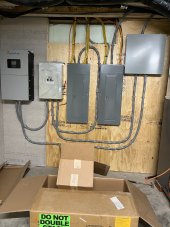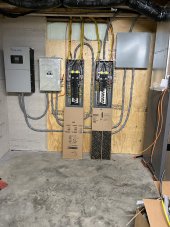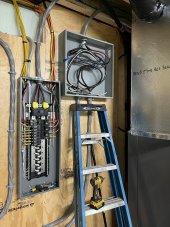Phone_Harold
New Member
- Joined
- Sep 30, 2019
- Messages
- 5
Will,
First time posting to the Forum!
I am in the process of building a new house, and I want to install solar day one with battery backup. So I want to get some opinions about the build.
The House I have faces west. The only clear view of the sky is south and west. The system has to be roof mounted as I do not have a place for a ground mount system. The house is 2,600 square feet and is located in Northeast Oklahoma. I estimate no solar exposure until 11 am. Our summer electric rates using time of day pricing are $ 0.15 peak and $ 0.09 off-peak.
I will have one Main Panel at the Minimum Point of Entry for the electrical system. On it, I will have breakers for 3 220 Outlets in the Garage for future EVs, 1 breaker for Electric Dryer, 1 breaker for the 'Medium' loads, 1 breaker for 'Protected' loads, and 1 breaker for Protected Loads bypassing Inverter. At the Inverter, there will be a switch to bypass the inverter. For the Furnace, I will have a light switch so it could be fed off the 'Medium' loads panel in the summer or the 'Protected' load panels for Natural Gas heat in the winter. I want Solar to work in the case of power loss as we can have multiday power outages
1 -- Small System with a 3KW inverter, two EG-4 batteries for 10KW of backup. The inverter will cover Lights, TV, Freezer, Residential Frig, and limited outlets. No 240v capability. May have a manual interlock for energizing the 'Medium' loads panel. Shooting for 2 to 4 KW of solar.
2 -- Medium System with a 6KW system with 220v for one or two 'Mr. Cool' like heat pumps to use when power is out, and all outlets covered. I will have the manual interlock for energizing 'Medium' loads panel. Shooting for 4 to 6Kw on the roof. Plan to have four EG-4 batteries for 20KW of backup.
3 -- Large System with 12Kw Inverter covering the entire house and 5 tons of AC. I would exclude EV charger and Dryer. Plan to have 6 to 8 KW on the roof. Plan to have four EG-4 batteries providing 30KW of backup.
For the Small to Medium system, I am looking at Victron with the flexibility and management of all the components.
I would like to use a Sol-ark in the medium or large system, and use the 'back feed' option to cover the high loads and possibly do net metering with the Utility. My utility requires time-of-day pricing with peak between 2 pm and 7 pm with all other hours as off-peak. Not sure I want to cycle the batteries to shave off-peak pricing with a pricing delta of 8 cents. Because of my orientation, I would like to have more than two charge controllers so I do not have to put the panels in series. I could do series-parallel, but having 30 amps, I do not know the size of wire I will need.
I do like the 'David Poz' solution of two 240v 5K inverters with an autotransformer, however, the Growwats are not very efficient nor can I do back-feeding and/or net metering, and I do not know if I can pass electrical inspection. Would MPP be a better choice?
If you were to build a system like this, what would you do? Are my systems too small or too large? (I do not have good usage data on my loads, so one's experiences would be helpful!) Any input on Solar Panels since the available roof area is limited is also appreciated?
It is not often one can install a Solar System on day one on a new house!
Harold.
First time posting to the Forum!
I am in the process of building a new house, and I want to install solar day one with battery backup. So I want to get some opinions about the build.
The House I have faces west. The only clear view of the sky is south and west. The system has to be roof mounted as I do not have a place for a ground mount system. The house is 2,600 square feet and is located in Northeast Oklahoma. I estimate no solar exposure until 11 am. Our summer electric rates using time of day pricing are $ 0.15 peak and $ 0.09 off-peak.
I will have one Main Panel at the Minimum Point of Entry for the electrical system. On it, I will have breakers for 3 220 Outlets in the Garage for future EVs, 1 breaker for Electric Dryer, 1 breaker for the 'Medium' loads, 1 breaker for 'Protected' loads, and 1 breaker for Protected Loads bypassing Inverter. At the Inverter, there will be a switch to bypass the inverter. For the Furnace, I will have a light switch so it could be fed off the 'Medium' loads panel in the summer or the 'Protected' load panels for Natural Gas heat in the winter. I want Solar to work in the case of power loss as we can have multiday power outages
1 -- Small System with a 3KW inverter, two EG-4 batteries for 10KW of backup. The inverter will cover Lights, TV, Freezer, Residential Frig, and limited outlets. No 240v capability. May have a manual interlock for energizing the 'Medium' loads panel. Shooting for 2 to 4 KW of solar.
2 -- Medium System with a 6KW system with 220v for one or two 'Mr. Cool' like heat pumps to use when power is out, and all outlets covered. I will have the manual interlock for energizing 'Medium' loads panel. Shooting for 4 to 6Kw on the roof. Plan to have four EG-4 batteries for 20KW of backup.
3 -- Large System with 12Kw Inverter covering the entire house and 5 tons of AC. I would exclude EV charger and Dryer. Plan to have 6 to 8 KW on the roof. Plan to have four EG-4 batteries providing 30KW of backup.
For the Small to Medium system, I am looking at Victron with the flexibility and management of all the components.
I would like to use a Sol-ark in the medium or large system, and use the 'back feed' option to cover the high loads and possibly do net metering with the Utility. My utility requires time-of-day pricing with peak between 2 pm and 7 pm with all other hours as off-peak. Not sure I want to cycle the batteries to shave off-peak pricing with a pricing delta of 8 cents. Because of my orientation, I would like to have more than two charge controllers so I do not have to put the panels in series. I could do series-parallel, but having 30 amps, I do not know the size of wire I will need.
I do like the 'David Poz' solution of two 240v 5K inverters with an autotransformer, however, the Growwats are not very efficient nor can I do back-feeding and/or net metering, and I do not know if I can pass electrical inspection. Would MPP be a better choice?
If you were to build a system like this, what would you do? Are my systems too small or too large? (I do not have good usage data on my loads, so one's experiences would be helpful!) Any input on Solar Panels since the available roof area is limited is also appreciated?
It is not often one can install a Solar System on day one on a new house!
Harold.





